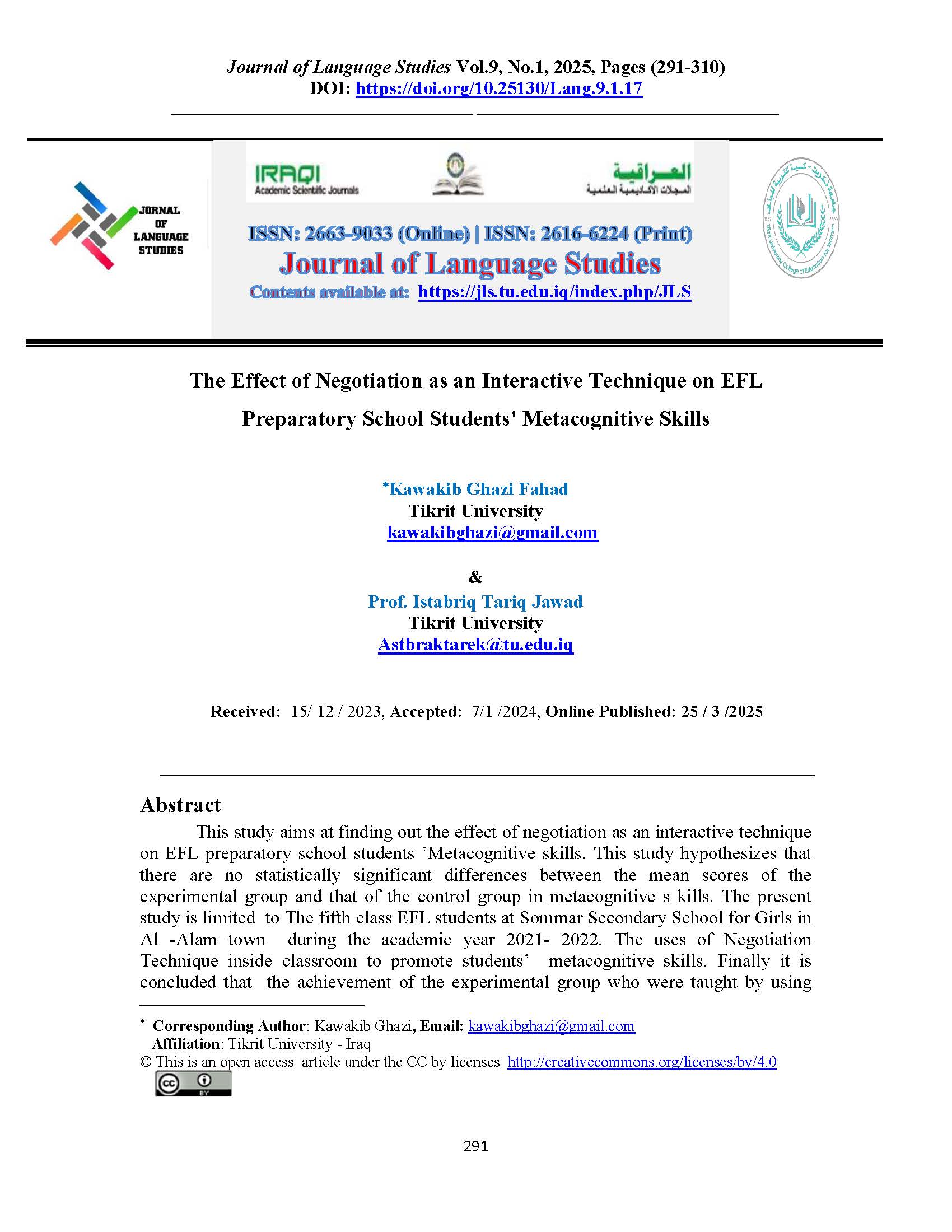The Effect of Negotiation as an Interactive Technique on EFL Preparatory School Students' Metacognitive Skills
DOI:
https://doi.org/10.25130/Lang.9.1.17Keywords:
negotiation, motivation, metacognitive skillsAbstract
This study aims at finding out the effect of negotiation as an interactive technique on EFL preparatory school students ’Metacognitive skills. This study hypothesizes that there are no statistically significant differences between the mean scores of the experimental group and that of the control group in metacognitive s kills. The present study is limited to The fifth class EFL students at Sommar Secondary School for Girls in Al -Alam town during the academic year 2021- 2022. The uses of Negotiation Technique inside classroom to promote students’ metacognitive skills. Finally it is concluded that the achievement of the experimental group who were taught by using negotiation technique has improved students metacognitive skills and applying the technique helps students lessen anxiety, shyness, and build self-confidence which helps them realize what they know about their cognition and how to regulate or control their cognition to perform something .
References
Brown, A. L. (1987). Metacognition, executive control, self-regulation, and other more mysterious mechanisms. In F. E. Weinert & R. H. Kluwe (Eds.), Metacognition, motivation, and understanding (pp. 65-116). Hillsdale, New Jersey: LawrUuU when, where and how to remember: A problem of metacognition. In R. Glaser (Ed.), Advances in instructional psychology ,Vol.1 (pp. 77-165). Hillsdale, NJ: Erlbaum
Black.B. and Wiliam,M. (1998) Assessment and classroom learning Assessment in Education: Principles, Policy & Practice, 5 (1) (1998), pp. 7-74
Bigozzi, L & Vezzani, C. (2005). "Role Of Individual Writing on Metacognitive Awareness in Scientific Concepts Learning".A study conducted by the Department of Psychology, University of Florence Italy.
Efklides, A. (2006). Metacognition and affect: What can metacognitive experiences tell us about the learning process? Educational Research Review, 1, 3-14.
Flavell, J. H. (1979). Metacognition and cognitive monitoring: A new area of cognitive–developmental inquiry. American Psychologist, 34, 906–911 .
Flavell, J.H. (1981). Cognitive monitoring. In W. P. Dickson (Ed.), Children's oral communication skills (pp.35 - 60). New York: Academic Press.
Gass, S. M. (2003). Input and interaction. In C. J. Doughty & M. H. Long (Ed.), The Handbook of Second Language Acquisition Malden, MA: Blackwell
González, et al ,2017 A. González, M.V.C.Fernández, P.V. Paoloni .Hope and anxiety in physics class: Exploring their motivational antecedents and influence on metacognition and performance Journal of Research in Science Teaching, 54(5) (2017), pp. 558-585
Long, M. H. (1996). The role of the linguistic environment in second lan- guage acquisition. In W. e. Ritchie & T. K. Bhatia, eds., Handbook of Second Language Acquisition (pp. 413-468). San Diego: Academic Press.
Lai, E. (2011a). Critical thinking: A literature review. Pearson Research Report. Retrieved from from http://images.pearsonassessments.com/images/tmrs/CriticalThinkingReviewFINAL.pdf
McGuire, S.Y. and McGuire, S. (2016). Teach Students How to Learn: Strategies You Can Incorporate in Any Course to Improve Student Metacognition, Study Skills, and Motivation. Sterling, Virginia: Stylus Publishing, LLC.
Mason, L & Nadalon, C. (2005). Measuring High School Students’ Metacognitive Knowledge,skills and Attitude through AILI Relationship With Gender, Grade, Curriculum And Achivement. Study conducted at University of Padua, Italy.
Nunan, D. (1989). Designing tasks for the communicative classroom. Cambridge: Cambridge University Press.
Nelson, T. and Narens, L. (1990). Metamemory: A theoretical framework and new findings. Psychology of Learning and Motivation, 26, 125–173..
Pica, T. & C. Doughty. 1985. “Input and interaction in the communicative classroom: Teacher- fronted vs. Group activities”. In Gass, S. D. & Madden, C. (eds.), Input in Second language acquisition. Newbury House.
Rysz, T. (2004). Metacognition in Learning Elementary Probability and Statistics. An unpublished EdD thesis. University of Cincinnati. USA.
Sudman, S. and Norman M. (1982.) Asking Questions: A Practical Guide to Questionnaire Design. (San Fransisco: Jossey-Bass Publishers.
Schraw, G. & Dennison, R. (1994). Assessing metacognitive awareness. Contemporary Educational Psychology, 19, 460- 475.
Schraw, G. (1998). On the development of adult metacognition. In: M. C. Smith & T. Pourchot (Eds.), Adult learning and development perspectives from educational psychology (pp. 89-106). Hillsdale, NJ: Erlbaum
Lee et al 2015. S.C. Lee, K. IrvIng, S. Pape, D.(2015) Teachers' use of interactive technology to enhance students' metacognition: Awareness of student learning and feedback. Journal of Computers in Mathematics and Science Teaching, 34 (2) , pp. 175-198
Warayet,A.(2011).ParticipationasacomplexphenomenonintheEFLclassroom.ThesissubmittedforthedegreeofDoctor
Zimmerman, B. (2000). Self-efficacy: An essential motive to learn. Contemporary Educational Psychology, 25(1), 82–91.
Zimmerman, B. J. (2001). Becoming a self-regulated learner: an overview. Theory Into Practice, 41(2), 64-70
Zohar, Anat, and Sarit Barzilai. 2013. “A Review of Research on Metacognition in Science Education: Current and Future Directions.” Studies in Science Education 49 (2): 121–69. https://doi.org/10.1080/03057267.2013.847261
Pintrich, Paul R. 2002. “The Role of Metacognitive Knowledge in Learning, Teach- ing, and Assessing.” Theory Into Practice 41 (4): 219–25. https://doi.org/10.1207/ s15430421tip4104_3
Cavagnetto A R Hand B and Norton-Meier L (2010) Negotiating the Inquiry Question: A Comparison of Whole Class and Small
Lai E R 2011 Metacognition: A Literature Review Pearson Research Report pp 40 http://images.pearsonassessments.com/images/tmrs/metacognition_literature_review_final.
Babbie, Earl, 1990. Survey Research Methods, Second Edition. California: Wadsworth Publishing Company.
Bradburn NM, Sudman S, Wansink B(2004). Asking Questions: The Definitive Guide to Questionnaire Design—For Market Research, Political Polls, and Social and Health Questionnaires San Francisco CA: John Wiley and Sons.
Wai-Ching Leung. How to design a questionnaire. Student BMJ. 2001 June;9:187 http://www.cochrane.es/files/Recursos/How_to_design_a_questionnaire.pdf
Mathers N, Fox N. and Hunn A.(2007) Surveys and Questionnaires. The NIHR RDS for the East Midlands / Yorkshire & the Humber, 2007.
Malhotra, N. K. (2006). Questionnaire design and scale development. The handbook of marketing research: Uses, misuses, and future advances, 83-94.
Krosnick, J. A. (2018). Questionnaire design The Palgrave handbook of survey research, Springer, 439-455.
Roopa S, Rani M.(2012). Questionnaire Designing for a Survey. J Ind Orthod Soc 2012;46(4):273-277.
Warayet,A.(2011).ParticipationasacomplexphenomenonintheEFLclassroom.ThesissubmittedforthedegreeofDocto of Philosophy School of Education, Communication, and Language Sciences. Faculty of Humanities and social sciences.Newcastle University UK.
Hacker,D.J ., Dunlosky, J,& Graesser, A.C.(2009). Handbook of metacognition in education . New York /London : Routledge.

